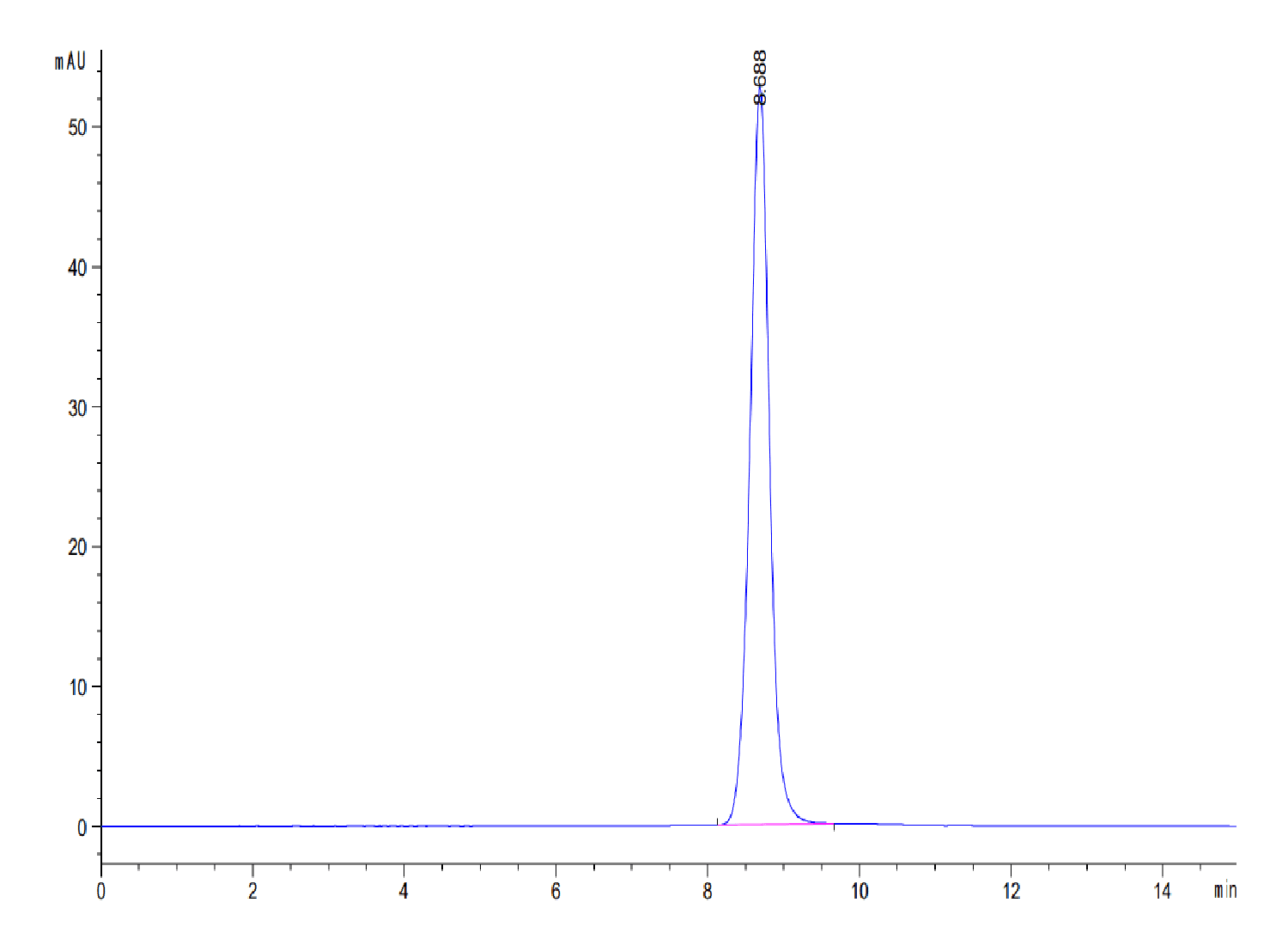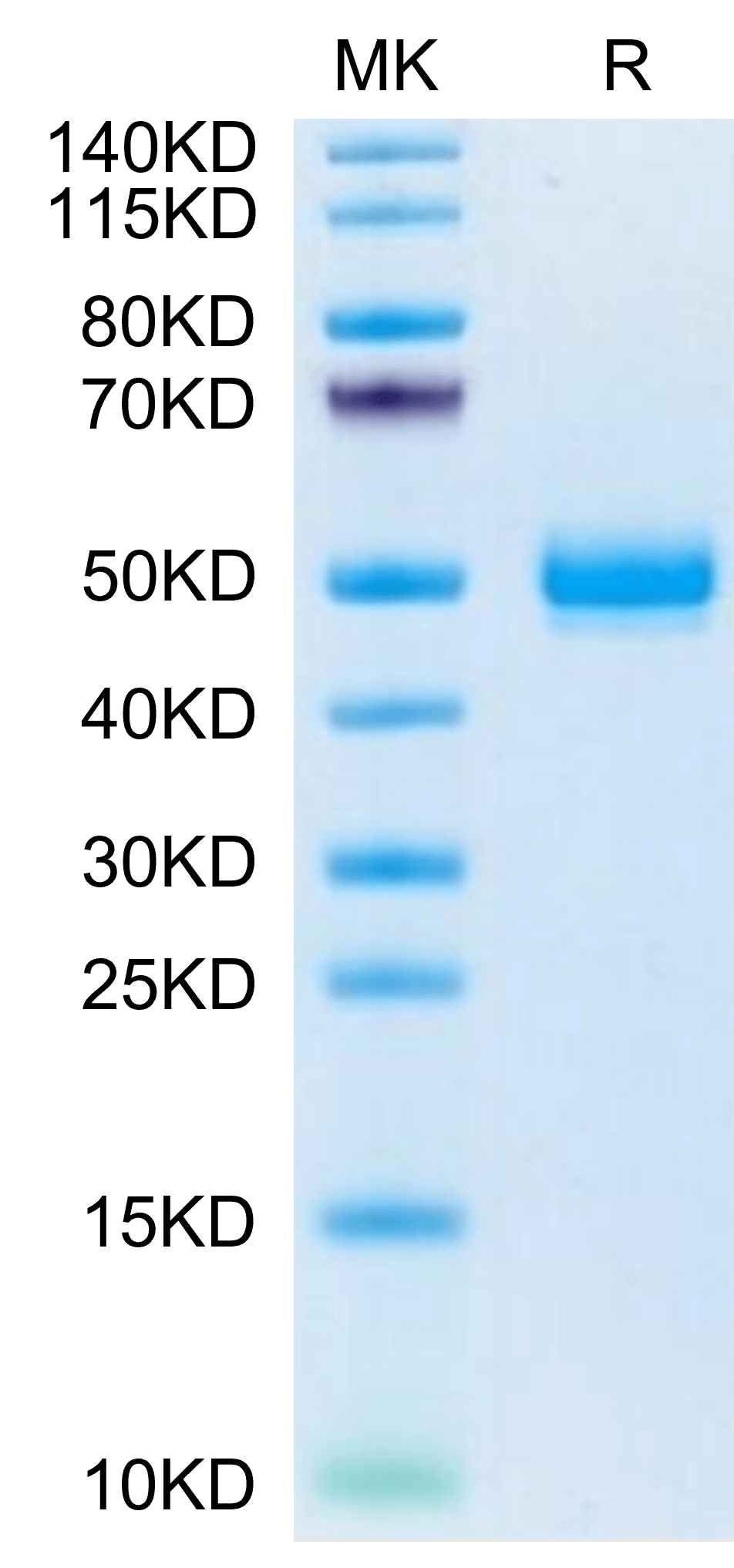| Weight | 1 lbs |
|---|---|
| Dimensions | 9 × 5 × 2 in |
| accession | Q60629 |
| express system | HEK293 |
| product tag | C-His |
| purity | > 95% as determined by Tris-Bis PAGE;> 95% as determined by HPLC |
| background | The aim of the present study was to evaluate ephrin type-A receptor 5 (EphA5) expression and its clinicopathological significance in gastric cancer. Gastric cancer tissues were analyzed by immunohistochemistry. The association between EphA5 expression and clinicopathological parameters, human epidermal growth factor receptor 2 (HER2) status and Ki-67 proliferation index was statistically analyzed. |
| molecular weight | The protein has a predicted MW of 43.9 kDa. Due to glycosylation, the protein migrates to 48-55 kDa based on Tris-Bis PAGE result. |
| available size | 100 µg, 500 µg |
| endotoxin | Less than 1EU per μg by the LAL method. |
Mouse EPHA5 Protein 4030
$315.00 – $1,050.00
Summary
- Expression: HEK293
- Pure: Yes (HPLC)
- Amino Acid Range: Pro27-Pro412
Mouse EPHA5 Protein 4030
| protein |
|---|
| Size and concentration 100, 500µg and lyophilized |
| Form Lyophilized |
| Storage Instructions Valid for 12 months from date of receipt when stored at -80°C. Recommend to aliquot the protein into smaller quantities for optimal storage. Please minimize freeze-thaw cycles. |
| Storage buffer Shipped at ambient temperature. |
| Purity > 95% as determined by Tris-Bis PAGE |
| target relevance |
|---|
| The aim of the present study was to evaluate ephrin type-A receptor 5 (EphA5) expression and its clinicopathological significance in gastric cancer. Gastric cancer tissues were analyzed by immunohistochemistry. The association between EphA5 expression and clinicopathological parameters, human epidermal growth factor receptor 2 (HER2) status and Ki-67 proliferation index was statistically analyzed. |
| Protein names Ephrin type-A receptor 5 (EC 2.7.10.1) (Brain-specific kinase) (CEK-7) (EPH homology kinase 1) (EHK-1) |
| Gene names Epha5,Epha5 Bsk Ehk1 |
| Protein family Protein kinase superfamily, Tyr protein kinase family, Ephrin receptor subfamily |
| Mass 10090Da |
| Function Receptor tyrosine kinase which binds promiscuously GPI-anchored ephrin-A family ligands residing on adjacent cells, leading to contact-dependent bidirectional signaling into neighboring cells. The signaling pathway downstream of the receptor is referred to as forward signaling while the signaling pathway downstream of the ephrin ligand is referred to as reverse signaling. Among GPI-anchored ephrin-A ligands, EFNA5 most probably constitutes the cognate/functional ligand for EPHA5. Functions as an axon guidance molecule during development and may be involved in the development of the retinotectal, entorhino-hippocampal and hippocamposeptal pathways. Together with EFNA5 plays also a role in synaptic plasticity in adult brain through regulation of synaptogenesis. In addition to its function in the nervous system, the interaction of EPHA5 with EFNA5 mediates communication between pancreatic islet cells to regulate glucose-stimulated insulin secretion. |
| Catalytic activity BINDING 520..528; /ligand="ATP"; /ligand_id="ChEBI:CHEBI:30616"; /evidence="ECO:0000255|PROSITE-ProRule:PRU00159"; BINDING 546; /ligand="ATP"; /ligand_id="ChEBI:CHEBI:30616"; /evidence="ECO:0000255|PROSITE-ProRule:PRU00159" |
| Subellular location Cell membrane ; Single-pass type I membrane protein. Cell projection, axon. Cell projection, dendrite . |
| Tissues Specifically expressed in the brain. Highly expressed in hippocampus, tenia tecta, indusium griseum and piriform cortex. The highest level of expression is found in the CA3 region of the hippocampus and the pyramidal cell layer of the piriform cortex. In addition, elevated levels of expression are also found in amygdala, medial septum, nucleus of the diagonal band, and in olfactory bulb. Expressed in pancreatic islet cells (at protein level). Expressed in myogenic progenitor cells (PubMed:27446912). |
| Structure Heterotetramer upon binding of the ligand. The heterotetramer is composed of an ephrin dimer and a receptor dimer. Oligomerization is probably required to induce biological responses (By similarity). Interacts (via SAM domain) with SAMD5 (via SAM domain) (PubMed:29749928). |
| Post-translational modification Phosphorylated. Phosphorylation is stimulated by the ligand EFNA5. Dephosphorylation upon stimulation by glucose, inhibits EPHA5 forward signaling and results in insulin secretion. |
| Target Relevance information above includes information from UniProt accession: Q60629 |
| The UniProt Consortium |
Data
 |
| The purity of Mouse EPHA5 is greater than 95% as determined by SEC-HPLC. |
 |
| Mouse EPHA5 on Tris-Bis PAGE under reduced condition. The purity is greater than 95%. |
Publications
Publications
| pmid | title | authors | citation |
|---|---|---|---|
| We haven't added any publications to our database yet. | |||
Protocols
| relevant to this product |
|---|
Documents
| # | ||
|---|---|---|
| Please enter your product and batch number here to retrieve product datasheet, SDS, and QC information. | ||














